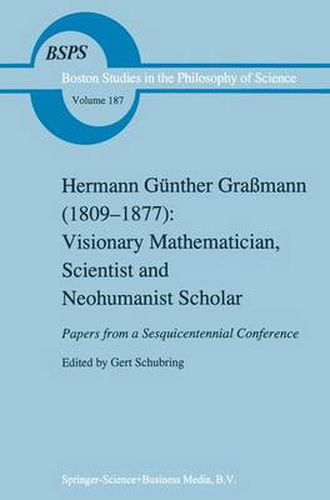Readings Newsletter
Become a Readings Member to make your shopping experience even easier.
Sign in or sign up for free!
You’re not far away from qualifying for FREE standard shipping within Australia
You’ve qualified for FREE standard shipping within Australia
The cart is loading…






This title is printed to order. This book may have been self-published. If so, we cannot guarantee the quality of the content. In the main most books will have gone through the editing process however some may not. We therefore suggest that you be aware of this before ordering this book. If in doubt check either the author or publisher’s details as we are unable to accept any returns unless they are faulty. Please contact us if you have any questions.
Hermann G. Grasmann (1809-1877) - mathematician, physicist, linguist, educator - was trained in the universalist scientific spirit of nineteenth-century neohumanism. That neohumanism postulated the ideal unity and complementarity of language and mathematics. Grasmann pursued the vision of that ideal unity, and upon it he rested his seminal achievements. While his writings on linguistics and physics enjoyed immediate influence, decades were to pass before mathematicians recognized the full power of his major work, the Lineale Ausdehnungslehre of 1844, to reshape the foundations of modern mathematics. In this volume specialists from several disciplines present a comprehensive analysis of Grasmann’s thought, its historical context and emergence, its reception, and its continuing influence on many branches of learning. The book addresses a general public in mathematics, physics, and linguistics, including graduate students in these fields, as well as historians of these disciplines.
$9.00 standard shipping within Australia
FREE standard shipping within Australia for orders over $100.00
Express & International shipping calculated at checkout
This title is printed to order. This book may have been self-published. If so, we cannot guarantee the quality of the content. In the main most books will have gone through the editing process however some may not. We therefore suggest that you be aware of this before ordering this book. If in doubt check either the author or publisher’s details as we are unable to accept any returns unless they are faulty. Please contact us if you have any questions.
Hermann G. Grasmann (1809-1877) - mathematician, physicist, linguist, educator - was trained in the universalist scientific spirit of nineteenth-century neohumanism. That neohumanism postulated the ideal unity and complementarity of language and mathematics. Grasmann pursued the vision of that ideal unity, and upon it he rested his seminal achievements. While his writings on linguistics and physics enjoyed immediate influence, decades were to pass before mathematicians recognized the full power of his major work, the Lineale Ausdehnungslehre of 1844, to reshape the foundations of modern mathematics. In this volume specialists from several disciplines present a comprehensive analysis of Grasmann’s thought, its historical context and emergence, its reception, and its continuing influence on many branches of learning. The book addresses a general public in mathematics, physics, and linguistics, including graduate students in these fields, as well as historians of these disciplines.